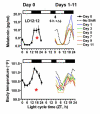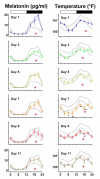Rapid phase adjustment of melatonin and core body temperature rhythms following a 6-h advance of the light/dark cycle in the horse
- PMID: 17718919
- PMCID: PMC2020455
- DOI: 10.1186/1740-3391-5-5
Rapid phase adjustment of melatonin and core body temperature rhythms following a 6-h advance of the light/dark cycle in the horse
Abstract
Background: Rapid displacement across multiple time zones results in a conflict between the new cycle of light and dark and the previously entrained program of the internal circadian clock, a phenomenon known as jet lag. In humans, jet lag is often characterized by malaise, appetite loss, fatigue, disturbed sleep and performance deficit, the consequences of which are of particular concern to athletes hoping to perform optimally at an international destination. As a species renowned for its capacity for athletic performance, the consequences of jet lag are also relevant for the horse. However, the duration and severity of jet lag related circadian disruption is presently unknown in this species. We investigated the rates of re-entrainment of serum melatonin and core body temperature (BT) rhythms following an abrupt 6-h phase advance of the LD cycle in the horse.
Methods: Six healthy, 2 yr old mares entrained to a 12 h light/12 h dark (LD 12:12) natural photoperiod were housed in a light-proofed barn under a lighting schedule that mimicked the external LD cycle. Following baseline sampling on Day 0, an advance shift of the LD cycle was accomplished by ending the subsequent dark period 6 h early. Blood sampling for serum melatonin analysis and BT readings were taken at 3-h intervals for 24 h on alternate days for 11 days. Disturbances to the subsequent melatonin and BT 24-h rhythms were assessed using repeated measures ANOVA and analysis of Cosine curve fitting parameters.
Results: We demonstrate that the equine melatonin rhythm re-entrains rapidly to a 6-h phase advance of an LD12:12 photocycle. The phase shift in melatonin was fully complete on the first day of the new schedule and rhythm phase and waveform were stable thereafter. In comparison, the advance in the BT rhythm was achieved by the third day, however BT rhythm waveform, especially its mesor, was altered for many days following the LD shift.
Conclusion: Aside from the temperature rhythm disruption, rapid resynchronization of the melatonin rhythm suggests that the central circadian pacemaker of the horse may possess a particularly robust entrainment response. The consequences for athletic performance remain unknown.
Figures



Similar articles
-
Absence of a serum melatonin rhythm under acutely extended darkness in the horse.J Circadian Rhythms. 2011 May 10;9:3. doi: 10.1186/1740-3391-9-3. J Circadian Rhythms. 2011. PMID: 21569251 Free PMC article.
-
Amplitude reduction and phase shifts of melatonin, cortisol and other circadian rhythms after a gradual advance of sleep and light exposure in humans.PLoS One. 2012;7(2):e30037. doi: 10.1371/journal.pone.0030037. Epub 2012 Feb 17. PLoS One. 2012. PMID: 22363414 Free PMC article. Clinical Trial.
-
Preflight adjustment to eastward travel: 3 days of advancing sleep with and without morning bright light.J Biol Rhythms. 2003 Aug;18(4):318-28. doi: 10.1177/0748730403253585. J Biol Rhythms. 2003. PMID: 12932084 Free PMC article. Clinical Trial.
-
From circadian clock mechanism to sleep disorders and jet lag: Insights from a computational approach.Biochem Pharmacol. 2021 Sep;191:114482. doi: 10.1016/j.bcp.2021.114482. Epub 2021 Feb 20. Biochem Pharmacol. 2021. PMID: 33617843 Review.
-
Circadian rhythm sleep disorders: pathophysiology and potential approaches to management.CNS Drugs. 2001;15(4):311-28. doi: 10.2165/00023210-200115040-00005. CNS Drugs. 2001. PMID: 11463135 Review.
Cited by
-
Daily rhythms of rectal and body surface temperatures in donkeys during the cold-dry (harmattan) and hot-dry seasons in a tropical savannah.Int J Biometeorol. 2018 Dec;62(12):2231-2243. doi: 10.1007/s00484-018-1626-z. Epub 2018 Oct 29. Int J Biometeorol. 2018. PMID: 30374600
-
Absence of a serum melatonin rhythm under acutely extended darkness in the horse.J Circadian Rhythms. 2011 May 10;9:3. doi: 10.1186/1740-3391-9-3. J Circadian Rhythms. 2011. PMID: 21569251 Free PMC article.
-
Investigation of a non-invasive method of assessing the equine circadian clock using hair follicle cells.J Circadian Rhythms. 2012 Oct 5;10(1):7. doi: 10.1186/1740-3391-10-7. J Circadian Rhythms. 2012. PMID: 23039139 Free PMC article.
-
A Review of Equine Sleep: Implications for Equine Welfare.Front Vet Sci. 2022 Aug 17;9:916737. doi: 10.3389/fvets.2022.916737. eCollection 2022. Front Vet Sci. 2022. PMID: 36061116 Free PMC article. Review.
-
Chronic phase advance alters circadian physiological rhythms and peripheral molecular clocks.J Appl Physiol (1985). 2013 Aug 1;115(3):373-82. doi: 10.1152/japplphysiol.01139.2012. Epub 2013 May 23. J Appl Physiol (1985). 2013. PMID: 23703115 Free PMC article.
References
-
- Winget CM, Deroshia CW, Markley CL, Holley DC. A review of human physiological and performance changes associated with desynchronosis of biological rhythms. Aviat Space Environ Med. 1984;55:1085–96. - PubMed
LinkOut - more resources
Full Text Sources
Other Literature Sources
Research Materials

